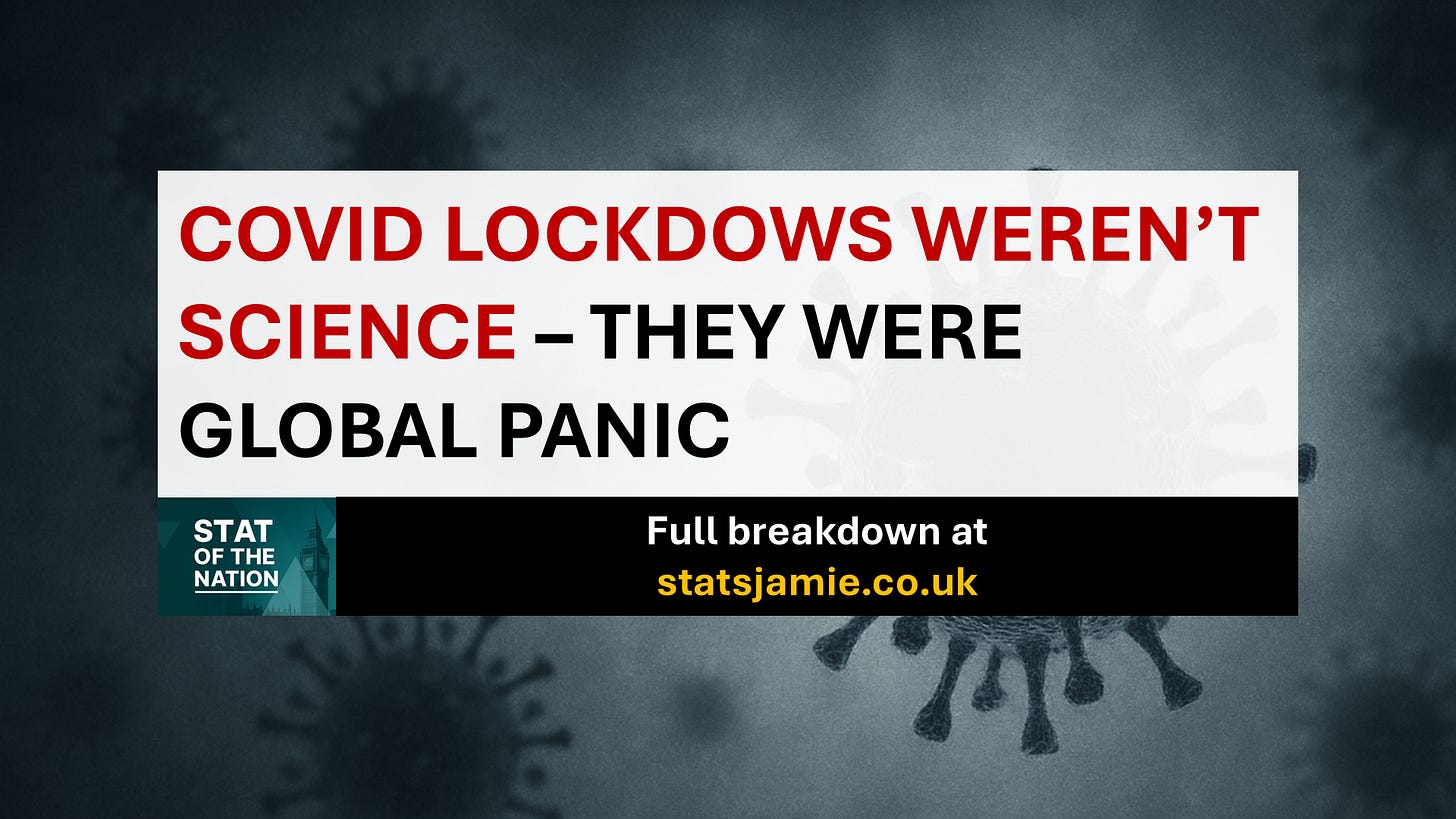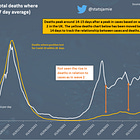The UK Covid Inquiry has published its findings, delivering a conclusion as neat as it is reassuring: Britain acted too slowly. A lockdown one week earlier would have saved 23,000 lives.
It is a seductive narrative. It suggests that if we had just pulled the “stop” lever a few days sooner, the catastrophe would have been averted. It absolves the machinery of government by reducing the disaster to a timing error.
But this version of history asks us to forget what actually happened. It asks us to pretend that the global response was rational and grounded in science.
It wasn’t. It was a global panic.
🌍 The Global Domino Effect
Lockdown was not a pre-planned scientific intervention; it was policy contagion.
It began in Italy. As hospitals in Lombardy collapsed, Rome pulled the emergency brake. Within days, fear spread faster than the virus. Spain copied Italy. France copied Spain. In London, the UK government—initially resistant—panicked and fell in line.
“If Italy is doing it, we must.” “If France is doing it, we must.”
This wasn’t science; it was herd behaviour. Governments were terrified of being the outlier. But one country refused to join the stampede: Sweden.
While the rest of Europe copied China’s authoritarian playbook, Sweden stuck to traditional pandemic principles: protect the vulnerable, keep society functioning, and keep schools open. They were vilified for it. But the data on excess mortality—the only metric that truly counts—suggests that Sweden may have been the only adult in the room. The “herd” wasn’t following science; they were following each other off a cliff.
⏳ The “Lost Week” Myth
The Inquiry’s central claim is that the government waited too long to force people to stay home. This ignores a crucial fact: the British public was already ahead of them.
Data shows that long before the Prime Minister issued the legal order on March 23, the country had already begun to shut down. Offices emptied. Travel plummeted. Households voluntarily isolated.
The Inquiry report itself admits that the government delayed action partly because scientific advisers believed the public would suffer from “behavioural fatigue”—a theory the report now condemns as having “no grounding in behavioural science”.
The public didn’t need a police state to act responsibly. They needed data, which the government failed to provide because community testing was abandoned on March 12. Blaming the rise in cases on the lack of a legal order ignores the reality that voluntary action was already breaking the chains of transmission; we were just flying blind because the state had turned off the radar
📉 The Omicron “Smell Test”: How the Modelling Failed
This brings me to the credibility of the numbers we are being fed. In December 2021, the airwaves were dominated by “Reasonable Worst Case Scenarios” from SAGE—championed by Professor Neil Ferguson—predicting up to 5,000 deaths a day unless we locked down.
At the time, I wrote that these numbers failed a basic “smell test.” When I sat down with the calculator, the math simply didn’t add up. As I noted in my blog back then:
“Various media outlets led with the 5,000 deaths a day headline... sadly nobody checked the maths. To get to 5,000 deaths, we would need nearly 56 million infections across the population in just six weeks... Professor Ferguson must expect more than double the cases in the next 6 weeks than what we have identified over 21 months.”
It was mathematically implausible—requiring the entire population to be infected almost overnight. Yet, this was the “science” driving the calls for cancelling Christmas.
After this winter passed, we could track back and see that the actual peak in deaths was 93% lower than the central scenarios produced by the Warwick models for SAGE.
“The official data shows that the reality was the peak in Covid-19 deaths was 93% lower than the SAGE model used to call on Boris Johnson to issue more restrictions... Whichever way you look at it, the SAGE prediction is way off and unfit for purpose.”
🔢 The Phantom 23,000: Why Retrospective Modelling Can’t Be Trusted
This brings us to the claim that locking down one week earlier in March 2020 would have saved 23,000 lives.
It is a precise, emotive, and devastating number. It is also the product of the same modelling machinery that failed the “smell test” on Omicron.
We are being asked to believe that the same models which overestimated Omicron deaths by 93% are somehow capable of calculating—with pinpoint accuracy—what would have happened in a parallel universe five years ago.
Consider the track record. In December 2021, these models could not accurately predict the outcome of a wave that was already happening, with the data we already had. Yet we are supposed to blindly accept their calculation of a hypothetical scenario from March 2020?
If you apply the same margin of error to the “23,000 lives” claim that we saw with the Omicron predictions, the certainty evaporates.
The “23,000” figure is not a fact; it is a guess produced by a calculator that has repeatedly proven to be calibrated to panic. It assumes that a legal order would have instantly frozen the virus, ignoring the real-world data showing that voluntary behaviour changes were already suppressing the spread before the politicians even moved.
If we cannot trust the models to tell us what will happen next week, we certainly shouldn’t trust them to rewrite history.
👶The Betrayal of Children
Perhaps the most damning admission in the Inquiry’s report is hidden in the section on vulnerabilities. It gently concedes that children “were not always prioritised”.
The truth is far harsher. Children were sacrificed to preserve a political narrative.
Schools were shut. Playgrounds were taped off. Young people, at negligible risk from the virus, were forced to pay the highest price to protect adults. The Inquiry notes that the government “failed sufficiently to consider the consequences of school closures”. That is putting it mildly. They sidelined a generation.
🧠The Real Lesson
The Inquiry offers a comforting bedtime story: “If only we’d locked down sooner, everything would have been fine.”
It is a dangerous lesson. It suggests that the solution to every future crisis is faster, harder authoritarianism.
The evidence tells a different story. It tells us that voluntary measures work. It tells us that the “herd” often panics. And it tells us that when politicians rush to copy their neighbours, relying on broken models that fail the basic smell test, it is the most vulnerable—and our children—who pay the price.
We don’t need a “healthier” version of the past. We need the truth.
✍️ Jamie Jenkins
Stats Jamie | Stats, Facts & Opinions
📢 Call to Action
If this helped cut through the noise, share it and subscribe free at statsjamie.co.uk — get the stats before the spin, straight to your inbox (no algorithms).
📚 If you found this useful, you might also want to read:
📲 Follow me here for more daily updates:













